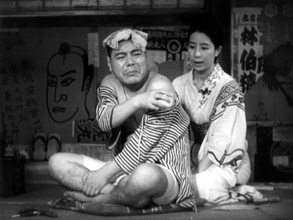Eine Geschichte von treibenden Gräsern / A Story Of Floating Weeds
Ozu Yasujiro
Japan 1934

|
Arsenal 12.02.2003, 18:00 |
Download Katalog / Catalogue (Ozu PDF)
Produktion: Shochiku (Kamata)
Weltvertrieb: Shochiku Co., Ltd. International
Business Division, 4-1-1 Tsukiji,
Chuo-ku, Tokyo, 104-8422, Japan
Tel: (81-3) 5550 1623, Fax: 5550 1654
E-mail: ibd@shochiku.co.jp
Buch: Ikeda Tadao
Kamera, Schnitt: Shigehara Hideo
Licht: Nakajima Toshimitsu
Bauten: Hamada Toshio
Darsteller: Sakamoto Takeshi, Iida Choko,
Mitsui Hideo, Yagumo Rieko
Format: 35mm, 1:1.37, s/w
Länge: 86 Minuten, 24 Bilder/Sek.
Sprache: Japanisch
The film tells the story of Kihachi, the leader of a group of travelling actors who perform humorous sketches and excerpts from famous Kabuki plays in small towns and villages. One day, Kihachi’s troupe is playing in the town in which Otsune lives, the woman he was in love with many years ago. Kihachi is pleased to see her and his son Shinkichi again, even though Otsune wants him to pretend to the child that he is his uncle. He accepts this solution because he thinks it is better the boy doesn’t know that his father is only an itinerant actor. When Otaka, the troupe’s principal actress, with whom Kihachi has lived for a long time, hears of his secret family rendezvous, she tries everything to prevent losing him. She tells Shinkichi who his father really is and therefore destroys any hope Kihachi has of living out his life in peace. He realises that there is no way he can go back to leading a normal life, and heads off for the next town with Otaka and his troupe. “The film is played in a remote rural village, a realistic locale for the travelling troupe but an unusual setting for Ozu at this point in his career. The cinéaste of urban Tokyo must now impose his narrational system on a different Japanese iconography: the village street, the landscape, the forlorn cafe, the decaying theatre.” David Bordwell
Ozu Yasujiro (1903–1963). Ausbildung in einer Filmfirma. Filme seit 1927, zunächst Slapstick-Komödien und Gangsterballaden, danach viel bewunderte Gegenwartsfilme, die ihn zum Chronisten der Gesellschaft machten, u.a. Tokyo monogatari (1953), Soshun (1956), Kohayakawa-ke no aki (1961), Samma no aji (1962).